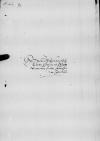Letter #1837
Ioannes DANTISCUS to Tiedemann GIESEHeilsberg (Lidzbark Warmiński), 1538-03-05
English register:
Dantiscus is passing on a letter for the [Ermland (Warmia)] Chapter to see, which he received from the Duke [Albrecht I von Hohenzollern], concerning the construction of an embankment in Bischofsburg (Bisburg), and asks for the Chapter’s opinion on the matter. He declares his willingness to do the Duke a favour in the name of consolidating their mutual friendship. He will send his people there on April 1, unless the Chapter objects.
The day before, Dantiscus received a letter from Johann von Werden requesting that he postpone the decision on beer duties until the Gdańsk (Danzig) Town Council send an envoy. Dantiscus considers this pointless. He asks Giese once again to let the Council know of his dissatisfaction with this kind of tax. He insists that Felix [Reich] come to him to discuss the matter of the curate’s office and many other issues he will recount to Giese upon the return.
Manuscript sources:
Prints:
| ||||||
Text & apparatus & commentary Plain text Text & commentary Text & apparatus
Reverendissimo Domino
Reverendissime Domine, frater et amice carissime ac honorande.
Salutem et fraterni amoris commendationem.
Rescripsit mihi
illustrissimus
dominus
De teloneo cervisiae, quod nostri Gdanenses[3] mordicus tenere videntur, heri iterum a communi amico nostro, domino
Quam diutissime fraterno affectu faustiter valere cupio.
Ex
Reverendissimae Dominationis Vestrae frater integerrimus,
[2 ] I. e. 1538-04-01
[3 ]
[4 ] Having fallen vacant after

